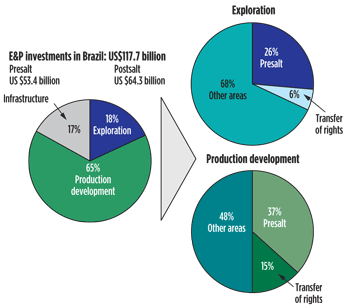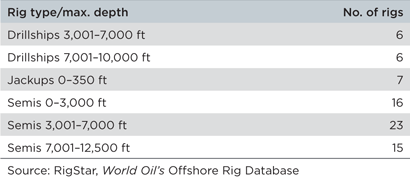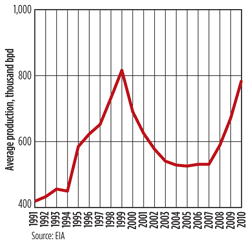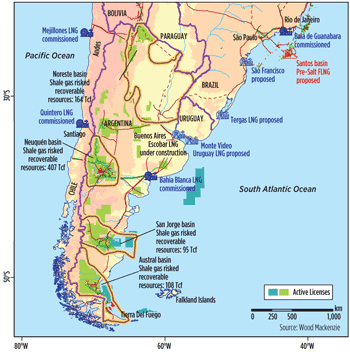Regional Report: Latin America
DAYSE ABRANTES, Contributing Editor, Latin America; and DAVID MICHAEL COHEN, Managing Editor New exploration opportunities in Latin American countries draw large investments—where government policies allow
With oil reserves second only to the Middle East and a rapidly expanding natural gas sector, Latin America has become an increasingly important focus of exploration and production efforts in recent years. Brazil’s massive presalt discoveries have attracted an influx of foreign and domestic investment that is widely expected to propel that country within the next few years into the ranks of the world’s top five crude oil producers. Other Latin American countries are also welcoming the technology, capital and expertise of foreign companies, but under terms and conditions that vary greatly from country to country. Meanwhile, investors are carefully monitoring the effects on the energy sector of this year’s presidential elections in Peru, Guatemala, Argentina and Nicaragua and 2012 elections in Mexico and Venezuela. At present, the latter country’s politics, economy and oil and gas industry are shadowed by uncertainty due to President Hugo Chavez’s ongoing battle with cancer (see column on p. 25). Colombia’s oil production is increasing rapidly—in fact, faster than its processing and transport infrastructure can handle—mainly due to the improved investment climate for foreign firms and increased security, which has dramatically reduced the incidence of guerrilla attacks on pipelines. In other countries, potential investors have been scared away by cumbersome legal or commercial restrictions. IOCs are intrigued by the substantial tight and shale gas resources in Argentina’s Neuquén, Noreste, San Jorge and Austral basins, but the government-imposed price cap on natural gas makes exploration of these plays economically difficult. In Mexico, 2008 legislation enabling state-owned Pemex to sign incentive-based service contracts with foreign oil companies has failed to stem production declines, and 2011 drilling activity is expected to fall far short of the company’s ambitious plans announced late last year. BRAZIL’S RESERVES TO DOUBLE ON PRESALT ADDITIONS Despite all the headlines, Brazil’s presalt accounts for just 2% of current expenditures by state oil firm Petrobras, but that share is set to increase dramatically. The company’s new business plan, released in July, calls for investment in presalt projects to rise to 18% of expenditures in 2015 and 40.5% in 2020. Between now and 2015, Petrobras plans to invest $54 billion in presalt projects and increase presalt production to 543,000 bopd. Overall, the plan calls for $224.7 billion of total investment over the next five years, of which 95% will be spent in Brazil and 5% abroad. Through 2015, $127.5 billion will be invested into E&P, funding some 688 projects. Of the E&P total, $76.5 billion (65%) will go for development, $21.2 billion (18%) for exploration, and $20 billion (17%) for infrastructure, Fig. 1.
At a seminar last month on presalt development, Brazil’s Mines and Energy Minister Edison Lobão said the increased investment will contribute to likely increases of 185% in the country’s oil production and 280% in natural gas production in the next 10 years. Brazil’s proved reserves are also widely expected to increase substantially over the next 10 years; Petrobras president Jose Sergio Gabrielli has often said that by 2020 the country’s proved reserves will double, which is easy to believe when considering that most of the massive presalt discoveries have not yet been incorporated into that number—the exceptions being Lula and Cernambi fields (formerly Tupi and Iracema, respectively), which have now been placed on production. These two developments helped boost Brazil’s oil reserves 10.65% in 2010 to nearly 14.25 billion bbl, the biggest annual increase in the past eight years, according to the National Agency of Petroleum, Natural Gas and Biofuels (ANP). The agency, which reported its reserve numbers in February, also said that gas reserves increased 15.23%, ending 2010 at 14.9 Tcf. The presalt could push proved reserves even higher by 2020. The Brazilian government has been working based on an estimate of 50 billion bbl of technically recoverable oil in presalt deposits. However, a recent university study by two former Petrobras geologists concluded that there was more than double that amount—at least 123 billion bbl. Petrobras’ E&P plan calls for the installation of 54 new production systems by 2020, when the company production target is 6.418 million bpd, with about 2 million bpd coming from presalt. The company is building 28 new rigs in Brazil for deepwater exploration, primarily in presalt fields. The strategic plan also foresees 169 new platforms, 504 support vessels, 53 drilling rigs and 48 oil tankers by 2020. The type and water depth ratings of rigs currently drilling offshore Brazil are shown in Table 1.
Today, Brazil has the greatest demand for offshore oil production equipment of any country, so it is a very promising market for the industry’s equipment and service suppliers. For example, Weatherford International pioneered the development of a unique deepwater drill pipe riser system in Brazil that has been applied extensively in the Santos, Campos and Espirito Santo basins, Kyle Chapman, the company’s regional product and service line manager for Latin America, told World Oil. Companies that can provide most of the advanced equipment and services have created local subsidiaries or have bought or partnered with Brazilian companies to comply with ANP’s local-content rules, which require that 60% of goods and equipment be produced in Brazil. Besides resources and investment, Brazil will need clients, and the United States is among the countries expected to fulfill that role. In a visit to Brazil in March, US President Barack Obama pledged that the United States will be a “major customer” for Brazilian oil in the coming years. The advantages for the US were succinctly expressed by Brazilian President Dilma Rousseff in comments to reporters at that time: “Which other country in the world has the oil reserves that Brazil has, that is not at war, that does not have an ethnic conflict, which respects contracts, has clear democratic principles and vision, is generous and in favor of peace?” Production-sharing agreements. The new oil and gas regulatory framework ratified by Brazil’s Congress last year included the implementation of production-sharing agreements (PSAs) for the exploration, development and production of hydrocarbons in the presalt area; the framework has not changed for E&P in other areas. The main consequence of the transition from a concession contract system is a requirement for Petrobras to serve as the operator for all presalt blocks and participate with at least 30% where contracts have not yet been signed. The government’s interests in exploration, development and production of the presalt areas are represented by a new company, Petrosal, which will participate in the operating committees of all these areas with veto power. The production-sharing system will apply to new contracts signed for fields in about 72% of the currently interpreted presalt area, which measures about 500 mi × 125 mi. Previously awarded contracts, which involve roughly 28% of the presalt region, will remain unchanged. Eleventh licensing round. In April, the National Energy Policy Council (CNPE) authorized ANP to promote Brazil’s 11th licensing round for exploration and production blocks in onshore and offshore basins. The bidding, which is expected to take place late this year or early next year pending authorization by Rousseff, marks the first offering of offshore blocks since the ninth round was held in 2007. The 11th round will offer 174 blocks, half onshore and half offshore, covering a total area of about 47,100 sq mi divided into 17 sectors along nine states. No presalt areas will be offered, as these now fall under the new production-sharing system. However, one-third of the blocks to be offered are located in another promising exploration frontier: Brazil’s equatorial margin, extending from the mouth of the Amazon River in Amapá and Pará states to offshore Ceará, Maranhão and Rio Grande do Norte states. Prospectivity for this area is considered high, since Petrobras has already identified the source rock, migration pathway and trapping mechanisms of oil and gas there. Potential is believed to be similar to that in the Gulf of Guinea in West Africa, which is along the same latitude and shares many geological similarities. Huge discoveries of light oil have been made and brought successfully into production in Nigeria, in Ghana with the Jubilee discovery, offshore Ivory Coast, and in Equatorial Guinea. However, the enormous and complex sedimentation load of the Amazon River cone makes locating economic oil and gas deposits much more technically challenging. There will be 32 offshore blocks offered in the Foz do Amazonas basin, 26 in the Barreirinhas basin, and additional offshore blocks in the Pará-Maranhão (8), Ceará (11) and Potiguar (10) basins. Onshore blocks will be offered in the Parnaíba (20), Potiguar (20), Sergipe (25), Recôncavo (16) and Espírito Santo (6) basins. COLOMBIAN PRODUCTION BOOMING Improved security coupled with regulatory reforms have made the Colombian oil and gas sector increasingly attractive to foreign investors in recent years, leading to a dramatic increase in oil production since 2007, following years of steady decline, Fig. 2. Among the regulatory changes, Colombia has lengthened exploration licenses, lowered royalty rates and increased opportunities for private firms to participate in oil and gas ventures within its borders. Foreign firms may own 100% stakes in Colombian ventures, a practice nearly unheard of in South America.
Average oil output increased more than 30% from 2005 to 2010, and production broke historic highs in March, rising more than 15% (compared to March 2010) to 884,000 bpd of oil, the National Hydrocarbons Agency reported. The country is currently Latin America’s fourth largest producer, following Mexico, Venezuela and Brazil. Proved oil reserves stand at 1.9 billion bbl, and they are expected to increase significantly with new discoveries resulting from exploration in licensed areas that were auctioned last year. Additionally, Colombia is considered a potential unconventional gas player. A small country, Colombia only consumed 296,000 bpd last year, according to analysis by the US Energy Information Administration (EIA). Thus, more than half of Colombia’s 2010 production was exported—about 73% of it to the US. As Colombian imports have risen to become the 10th largest source of US oil imports, they have helped offset decreasing volumes from Mexico and Venezuela. In December 2010, the Colombian government announced plans to sell as much as 10% of state oil firm Ecopetrol, both to boost the country’s upstream oil industry and to pay for infrastructure repairs necessitated by severe flooding last year. Ecopetrol is Colombia’s largest oil and gas company, accounting for 60% of the country’s production. The government, which currently owns 89.9% of the company, will sell the shares over four years, according to statements by President Juan Manuel Santos. Separately, Ecopetrol in August completed a share sale for 2.4 trillion pesos ($1.34 billion), representing about 1.6% ownership, falling just short of its goal of 2.5 trillion pesos ($1.4 billion). The proceeds will go toward Ecopetrol’s aggressive E&P expansion efforts, which are aimed at boosting production to 1.5 million bpd by 2020. That’s double the company’s projected output of 750,000 bpd for 2011, which itself would represent a 22% jump from 610,000 bpd last year. The company has budgeted $8.54 billion this year, of which $1.3 billion is for exploration, including the drilling of at least 40 exploratory wells. More than half of these planned wells are within the onshore Cano Sur block, covering about 610,000 hectares in the Llanos Orientales basin. Ecopetrol owns 100% of the contract rights in the block after assuming all of the stake previously held by Shell earlier this year. In July, the company’s Fauno-1 exploratory well confirmed the block’s heavy oil potential, following three previous successful wells. On testing, Fauno-1 produced 12.3°API oil at an average rate of 132 bpd. MEXICO ON PATH TO BECOME AN IMPORTER The world’s seventh and the Western Hemisphere’s third largest oil producer in 2010, Mexico is also the fifth largest non-OPEC producer, but analysts point to the danger of the country losing its oil exporter status by the end of the decade. That was the verdict of the EIA’s International Energy Outlook in 2010, which forecast that Mexico will be a net importer by 2020 and will have net imports exceeding 1 million bpd by 2035. In 2010, the country exported 1.3 million bpd of crude oil, the vast majority of it (1.14 million bpd) to the US. By law the sole operator in country, state oil firm Pemex has been unable to make sufficient investments and apply the necessary technology to counter steadily falling production at the aging giant Cantarell field, where production peaked at 2.1 million bpd in 2003 and ended 2010 at less than 500,000 bpd. In 2009, Cantarell fell behind the Ku-Maloob-Zaap (KMZ) complex, located just to the northwest in the Bay of Campeche, as Mexico’s most productive field. The trend of under-investment was continued early this year, when Pemex announced drastic cuts in its drilling program, to a planned 2011 well count of 580. The cuts include a two-thirds drop in drilling at the onshore Chicontepec heavy oil project and sharply reduced development activities at the Burgos basin gas fields. In contrast, last year Pemex drilled 994 exploration and development wells, including 816 in the northern region that holds Chicontepec and Burgos. The government hopes that the recent introduction of performance-based contracts in select fields—the first since the industry was nationalized in 1938—will help reverse Mexico’s E&P trajectory. The initial round of operating contracts was awarded in August—two to British energy services firm Petrofac and one to Mexico’s Administradora de Proyectos de Campo (APC)—for three mature oil fields in the southern region. The winning bids were those that offered the lowest cost per barrel of oil. Pemex will also partially reimburse costs and provide output- and cost-based bonuses. In addition to the contracts, Pemex plans to invest $23 billion this year to boost oil production. Offshore potential. Many analysts believe there is a huge potential volume of untapped hydrocarbons off the Mexican shelf, but the expense and complexity of drilling operations, installing subsea hardware and floating production systems in the deepwater Gulf of Mexico limits Pemex. However, the company is certainly putting in the effort; with plans to drill 44 exploration and appraisal wells offshore this year and maintain that level through 2015. Currently, Mexico has the second highest number of active offshore rigs in Latin America after Brazil, Table 2.
In a recent deepwater strategy presentation, Pemex officials said the company will call for bids on deepwater drilling contracts to foreign players by early 2012, including the supply and installation of subsea trees, risers, umbilicals, flowlines, separation and injection systems. Recently, the firm signed an $850 million five-year contract for SeaDrill’s new Pegasus ultra-deepwater rig. On the shallow side, in March the company leased seven jackups from Noble Corp. and extended the leases of 25 more. Wood Mackenzie estimates that most of the 50 or so development wells drilled offshore Mexico every year are in shallow waters. Pemex also announced plans to award $5 billion over the next two years for platform construction contracts. The 50 new production platforms will be installed on Campeche Bay on Ayatsil and Tsimin fields. Those two fields are estimated to contain oil reserves of up to 622 million bbl. Promising subsea developments include Noxal, Labay, Leek, and Lakach, all in the deepwater Coatzacoalcos basin. Another promising deepwater development, says Pemex, is the Lalail prospect in 2,600-ft water depth, expected to come onstream in 2015. Producing from more than 30 platforms, Cantarell contributed 22% of Mexico’s total crude oil output in 2010 (558,000 bbl/d). A major reduction in the number of wells is expected this year. KMZ contributed 32% of total Mexican production with 839,200 bpd, double the complex’s output four years ago when Pemex began reinjecting nitrogen there in an enhanced recovery program similar to one used at Cantarell. Challenging heavy crude onshore. Onshore fields represent only about 25% of Mexico’s total crude oil production. Most of that onshore oil (80%) comes from the southern part of the country, primarily from Samaria-Luna field, which produced about 200,000 bpd in 2010. Production in Mexico’s northern onshore basins is distributed among many small fields. Of these, Chicontepec, northeast of Mexico City, is seen as technically very challenging but as a large source of future production growth—if an aggressive drilling program can be carried out. Pemex estimates Chicontepec’s possible reserves at 17.7 billion bbl of oil equivalent. Currently, 29 fields in the basin are producing some 30,000 bpd, but some analysts believe this output could rise to 70,000 bpd by December, largely on the strength of last year’s development drilling. Maya heavy oil, with high sulfur content, represents about 60% of Mexico’s total crude oil production, and the bulk of it goes to the US Gulf Coast, where sophisticated refining capacity is available. Most of the lighter crude (Isthmus and Olmeca) stays for domestic consumption. Natural gas. Pemex produced its first shale gas in March from an exploratory well at the Eagle Ford formation in the northeastern state of Coahuila. This new exploration frontier notwithstanding, Pemex projects its natural gas output to fall substantially to 6.132 Bcfd by the end of the year, from 6.986 Bcfd at the close of 2010. The reduction is largely related to reduced development activity in the northern Burgos basin, where output is expected to be down 11.5% this year to 1.237 Bcfd despite three new gas fields that came online last year: Alambra, Arenaria and Perillan. Last year, the north represented 36% of gas production, the south contributed 25%, and offshore fields accounted for the remainder. That split could rapidly shift toward the north once Burgos activity really ramps up. Although southern Mexico contains the majority of the country’s 12 Tcf of proved gas reserves, probable and possible reserves are about 10 times higher in the north. For now, Mexico is still a net importer of gas, which is increasingly replacing oil as a feedstock in power generation, leading to higher imports as LNG and via 10 active pipeline connections with the US. Mexico imported 342 Bcf from the US last year, while also exporting 30 Bcf north of the border. PRICE CAPS DIMINISH ARGENTINE OUTPUT Although Argentina produces more natural gas than any other country in South America, but output now is more than 10% lower than peak levels in 2006. Having once been a net gas exporter to neighboring countries as well as the continent’s largest gas consumer, Argentina became a net importer in 2008. In that same year, the government introduced the Gas Plus program, intended in part to encourage development of Argentina’s considerable potential shale gas resources—estimated by the EIA at 774 Tcf, third globally after the US and China, Fig. 3. The program was designed to allow higher pricing for unconventional gas, new discoveries and incremental production from existing projects, easing the price caps that had limited the sector’s attractiveness to private investors.
The EIA estimates that Argentina produced 1.4 Tcf of dry natural gas in 2010, or about 4 Bcfd. The country has 460 active concessions over an area of 560,000 sq km, and the most promising areas are under license now. However, the gas-hungry country still faces a supply deficit. Last year, Argentina imported the equivalent of 22 cargoes of LNG, and the figure is expected to double in 2011. Bolivia is the main source of pipeline gas imports, with a contract for 272 MMcfd, to grow to nearly 1 Bcfd by 2017 and extend through 2026. The crippling problem for shale development is the extremely low price artificially imposed on gas, on average $2.51/Mcf ($4–$5 with Gas Plus). According to Wood Mackenzie, a minimum of $4/Mcf is needed for a shale investor or upstream producer to even start up a small project in Argentina, and a larger-scale development would require $5–$7/Mcf. Up to now, the contracts closed via Gas Plus have been deals with the government-owned Cammesa power agency. Nonetheless, the country’s unconventional potential is attracting some key service companies like Schlumberger and Weatherford. The latter, for example, is starting up operations in Argentina for its core analysis group (WTF Labs) and is in the process of mobilizing additional fracturing horsepower and coiled-tubing units to support future growth of activities in the Neuquén basin, in addition to other WTF services that have been available in Argentina for years. Neuquén is the most advances unconventional development area in the country to date. Officials in Neuquén province estimate potential unconventional gas reserves there at 257 Tcf, which would be about a third of Argentina’s total. Both Halliburton and Baker Hughes have recently fraced their first shale wells in Argentina. New E&P activities. Although conditions are not yet in place for full-scale unconventional development, tight gas production has begun with small-scale pilot projects, and some companies are also engaging in exploration and development activities, such as YPF, Total, Apache and ExxonMobil. Exxon has interest in four Neuquén basin blocks, and YPF last December discovered a large, commercially promising tight gas formation after drilling six wells. Also, after four wells drilled, YPF found what it estimated at 4.5 Tcf of shale gas potential near the Neuquén basin’s Loma La Lata field—so far, the only firm resource estimate confirmed by an upstream operator. In May, YPF announced a 150 million-bbl shale oil discovery in the Vaca Muerta formation at Loma La Lata. Apache, Total and Petrobras Argentina (owned 67.25% by Petrobras) are producing a total of about 180 MMcfd of tight gas in the Neuquén basin, which is being sold under small-scale, short-term Gas Plus contracts. Apache recently announced that it had drilled the first horizontal well for shale gas in Latin America, in the Los Molles formation. After drilling more than 70 wells in four Neuquén fields since 2008, Apache is also evaluating the gas potential of the Precuyo and Vaca Muerta formations. Of the four basins identified by the EIA, only Noreste has significant tracts of unlicensed acreage; only 11% of the basin’s 685,000 sq km is currently licensed. Offshore on the horizon. Some analysts point to the continuous production decline of onshore oil and gas fields over the last years as a reason for Argentina to start exploring its deepwater offshore potential. Last year, over 10% of Argentina’s gas production was from offshore resources, mostly from Cuenca Marina Austral-1 concession operated by Total. All offshore gas production derives from the Austral-Magallanes basin in the country’s extreme south, which includes federal waters off of the provinces of Tierra del Fuego and Santa Cruz. However, in August, Argentina’s state-run energy company, Enarsa, suspended plans to auction oil exploration rights at 32 offshore blocks. The blocks “to be auctioned later with more favorable conditions” are located in the Atlantic Ocean near Patagonia and include areas such as the Valdes Peninsula, San Jorge and Malvinas.
Click here for an online exclusive look at Weatherford operations in South America |
|||||||||||||||||||||||||||||||||||||
| THE AUTHORS | |||||||||||||||||||||||||||||||||||||
|
DAYSE ABRANTES is an independent journalist based in Rio de Janeiro. She has traveled widely in Latin America, and has written on the region’s energy sector for two decades. / daysew@frionline.com.br |
|||||||||||||||||||||||||||||||||||||
Related Articles
- Regional Report: Guyana-Suriname (July 2023)
- Regional Report: Brazil (February 2023)
- International Forecast: Some noticeable recovery is finally underway (September 2022)
- Guyana-Suriname Regional Report: The overly generous PSA may be history (July 2022)
- Characterizing seismic facies in a carbonate reservoir, using machine learning offshore Brazil (June 2022)
- 2022 Forecast: Activity outside North America will lead global recovery (February 2022)
- Applying ultra-deep LWD resistivity technology successfully in a SAGD operation (May 2019)
- Adoption of wireless intelligent completions advances (May 2019)
- Majors double down as takeaway crunch eases (April 2019)
- What’s new in well logging and formation evaluation (April 2019)
- Qualification of a 20,000-psi subsea BOP: A collaborative approach (February 2019)
- ConocoPhillips’ Greg Leveille sees rapid trajectory of technical advancement continuing (February 2019)








